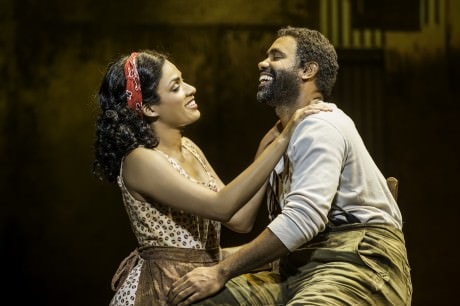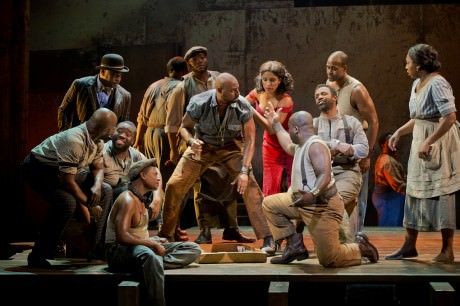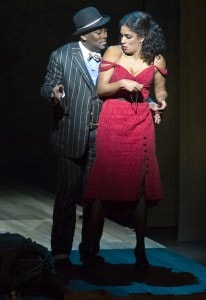There are many ways of presenting blackness on stage and defining blackness, and the theater remains a venue in which to challenge, question, and probe.

Yet, before The Gershwins’ Porgy and Bess made its Broadway debut, the reexamination of Porgy and Bess generated an intense cultural commentary and controversy as to whether this iconic work of art needed to be updated at all. Over the decades, Porgy and Bess has ignited social change, and carries historical significance with regards to race. In the past, slow changes to the masterwork have been made. In 1951, for example, Ira Gershwin removed all instances of the word “nigger” from the libretto for a Columbia Masterworks recording.
As attitudes about race have changed, so have perceptions of the work.
A question to consider is how do the new dynamics of race and representation relate to the demands of today? The revisions of The Gershwins’ Porgy and Bess for me are not about fixing, as much as it is an opportunity for deeper understanding, authenticity, and aesthetic standards. The core truthfulness and beauty of the original Porgy and Bess remain.
The genius of Gershwin’s music has never been in doubt.
Currently on the second stop of a fourteen-city national tour, the dramatics of The Gershwins’ Porgy and Bess tale of love, death, addiction, and hope is playing at the National Theatre in Washington, D.C. until this Sunday, December 29, 2013. Accessible, fresh, and realistic for today’s musical theater audiences, The Gershwins’ Porgy and Bess reinvigorated characters and a bolstered story is a fulfilling, satisfying experience.
Porgy and Bess, originally referred to as ‘An American Folk Opera’ is based on Dubose Heywards’s 1925 novel Porgy, and the 1935 opera Porgy and Bess is a benchmark of American music. Directed by Diane Paulus (2013 Tony winner for Pippin) and adapted by Pulitzer Prize-winning playwright, Suzan-Lori Parks, the reimagined musical version The Gershwins’ Porgy and Bess won the Tony Award in 2012 for Best Musical revival.
Conceived to bring the story to a broader audience beyond George and Ira Gershwin and DuBose and Dorothy Heywards’ classic 1935 opera, Parks said she wanted to adapt the book so that it matched the music in importance. “We wanted to make it better.”
The daunting challenge for Suzan-Lori Parks was adapting an opera written by white creative talent in the 1920s and 30s and figuring out how to approach the African-American characters. In the operatic version of Porgy and Bess, and even the 1959 film directed by Otto Preminger starring Sidney Poitier, Dorothy Dandridge, Sammy Davis, Jr, Brock Peters, and Pearl Bailey, it is difficult to get to know the heart and soul of the characters, especially Bess and Porgy. (In order to secure the film rights from the Gershwin Estate, MGM’s Samuel Goldwyn, signed a contract under the terms of which rights reverted to the estate after fifteen years. Except for rare screenings, the film has been officially unavailable for more than three decades).
Paulus and Parks have authoritatively recreated characters that are not caricatures, but real human beings filled with raw emotions. The dramaturgy is original and comes with deep understand of the African-American characters in South Carolina who live on Catfish Row. They have focused on telling the story in an intimate and more personal way – by giving a fully developed voice to the characters on Catfish Row.
Parks’ superior contribution of creating relatable character arcs for the leads and main characters strengthens the overall story presentation by enhancing the context, the emotional weight, and interpretation of the songs and musical numbers. The power of the language and imagery in The Gershwins’ Porgy and Bess presents the diversity while celebrating the unity amongst African-Americans.
This musical vision explores the diverse ways in which identities become articulated in culture, history and time. What comes through clearly now, is despite the pressure of external forces, the protagonists express the spirit to define themselves.
The Gershwins’ Porgy and Bess is a story of love and survival.
Diedre L. Murray’s Musical Score adaptation for The Gershwins’ Porgy and Bess and the lush William David Brohn/ Christopher Jahnke orchestrations are classical music, but the wide range of influences and sounds live and breathe like a jazz score. With the new orchestrations, played by an illustrious 23-piece orchestra, you can hear the musical homage to George Gershwin’s score for Porgy and Bess, the fusion of many different musical styles including jazz, classical, blues, gospel, and traditional musical theatre. The glorious songs of Porgy and Bess – “Summertime,” “I Got Plenty of Nothing,” and “It Ain’t Necessarily So” are performed around the world classics.
After a mood-setting, two-minute opening musical interlude, The Gershwins’ Porgy and Bess begins with a gorgeous vocal from Sumayya Ali (Clara) singing “Summertime.” This rendition is not your parent’s Porgy and Bess opera, but she along with Alicia Hall Moran (Bess) and Denisha Ballew (Serena), and the winning Nathaniel Stampley have impressive, operatic voices that easily could be found in an Opera House.
This cast can certainly sing but their acting skills are equally impressive.
The Gershwins’ Porgy and Bess musical tells the story of “Porgy,” a disabled black beggar who lives in the slums of Charleston, South Carolina’s fabled Catfish Row, and chronicles his resolute, courageous attempts to rescue the tantalizing Bess (Alicia Hall Moran) who struggles to break free from her formidable, dominating “husband” Crown (Alfred Crawford), a colorful troublemaker/drug peddler Sporting Life (Kingsley Leggs), and her scandalous past. Porgy and Bess’ evolving relationship develops into a committed romance that stands the test of time as a triumphant love story and a masterpiece of American Theatre.

The engaging, facially expressive Nathaniel Stampley injects Porgy with emotionally sincerity, strength, and fierce determination that make his character not only likeable, but genuine and convincing. The audience can believe that despite his physical limitations, this is a man who is committed to whatever he sets his mind to, and is one who loves fully. His feelings for Bess are real, and it is a testament to the power of his love that the audience can accept and believe the desire for change, and the love Bess has for him.
The timbre of Alicia Hall Moran’s mezzo soprano operatic voice is pure, but the cheek scar on the side of Bess’ face immediately establishes that she is damaged goods. Her rough-around-the edges exterior and talk are appropriately crude in the beginning. The audience gradually witnesses Bess’ unspoken desire to be a proper respectable woman, accepted by this African-American, Catfish Row community. I believed her every step of the way.
Sporting Life is a dapper, trickster and a calculating character that is never far away from offering his ‘happy dust” to weak and vulnerable souls.The costume design by Esosa tells you everything you need to know about this cunning personality as soon as he steps on the stage. It’s a great role and Kingsley Leggs brings a charisma and vitality to the character that makes him likeable – even when you know he’s no good. His performance of “There’s a Boat That’s Leaving Soon” is one of the evening’s memorable moments.
I could listen to David Hughey’s (Jake) voice for hours. His clear, rich tone is a pleasing to the ear and in complementary harmony with Ali (Clara)when he sings the “Summertime” duet. One of my favorite vocal moments in the production is when he and the Fishermen sing “It Takes a Long Pull.”
Alvin Crawford as Crown, is a menacing, intimidating presence. This is not a guy who you want to upset or get on his bad side. The biggest compliments that an audience can give a nasty character are Boo’s at the curtain call – and, that’s exactly what Crawford received for his convincing performance as Crown on Opening Night.
This production has a lot of heart, and the enthusiastic spirit, and genuine articulation of spirituality is as refreshing as it reassuring. Danielle Lee Greaves’ interpretation of the God-fearing Mariah is a powerful voice and she commands respect. All of the characters come from something honest – how people honestly feel and treat each other in a real way – and that’s when things get magical. This magnetic ensemble cast has a knack for depicting the hard-luck, tough living individuals who survive the harshness and cruelties of the times with singing, laughing and a little dancing, a whole lot of praying … and sometimes even a picnic.

Ronald K. Brown’s choreography and the whipping arms, stamping feet, and bent backs of African dance represent celebration and grief in the characters’ bodies, rooted in tradition. The natural movement of the community in the dance sequences, especially in the funeral and picnic scenes, excavates who the people are and expresses their Gullah cultural origins.
Riccardo Hernandez’ Scenic Design is minimal but intimate and timeless in its humanity. The stripped down wood boards and peeling paint canvas are designed to illustrate only the essential. Hernandez has created a mythic space with Catfish Row, a place of gathering and community where the humanity and emotions of the people are exposed. It is abstract and universal.
Complementing the set design and the complexity of the story is Christopher Akerlind’s lighting design creating a changing palate of rich colors – hot, sultry summer of luminescent yellows, orange, peach, and reds – transitioning into darker blue and green tones as dictated by the emotional tone of the story.
Diane Paulus, Suzan-Lori Parks, Diedre L. Murray, and the entire creative team are successful in engaging the audience with Clara and Jake, Porgy and Bess, Crown, Sporting Life, and all of the recognizable ensemble characters from the moment they step on stage until the minute they leave.
Indeed the time is right for a new musical theater production of Porgy and Bess.
Running Time: Two hours and 30 minutes, with a 15-minute intermission.
The Gershwins’ Porgy and Bess plays through this Sunday, December 29, 2013 at The National Theatre – 1321 Pennsylvania Avenue, NW, in Washington, D.C. Tickets can be purchase by calling (800) 514-3849 or online.
LINK
John Stoltenberg on The Gershwins’ Porgy and Bess in his Magic Time! column.




